North Dakota is known for being a bird-friendly state, with a nickname like ‘The Peace Garden State.’ The Hills, with their sculpted domes and pyramids, the lush Drift Plains, and the gorgeous Missouri Plateau, provide a variety of attractive areas that attract a variety of birds to come here.
Today, we’ll take a look at some of North Dakota’s most popular backyard birds.
North Dakota is home to an astonishing 376 species of birds, including carved domes and pyramids in the Badlands and the lush Drift Prairie, and the lovely Missouri Plateau.
| Image | Name |
|---|---|
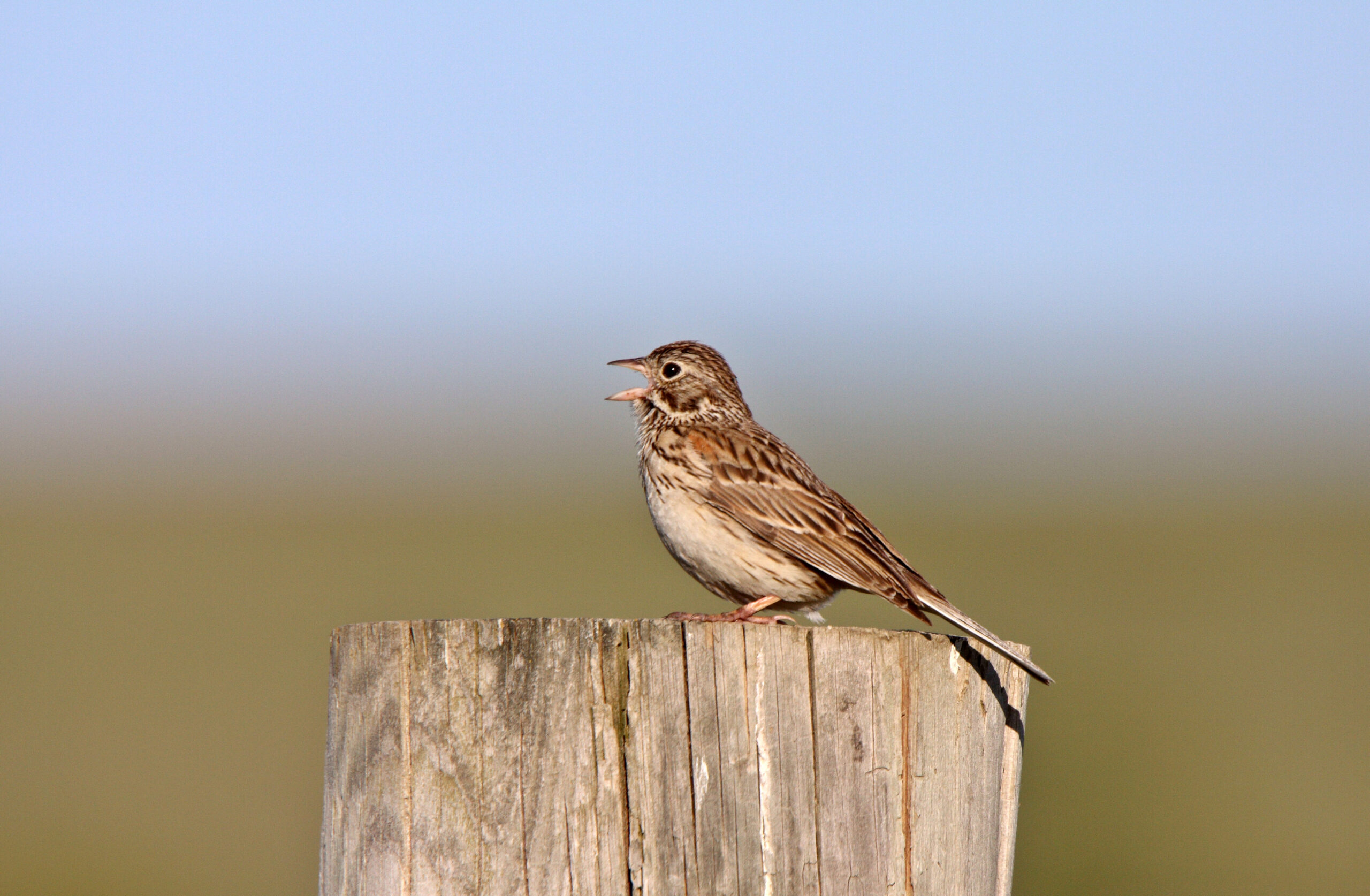 | Song Sparrow |
 | American Robin |
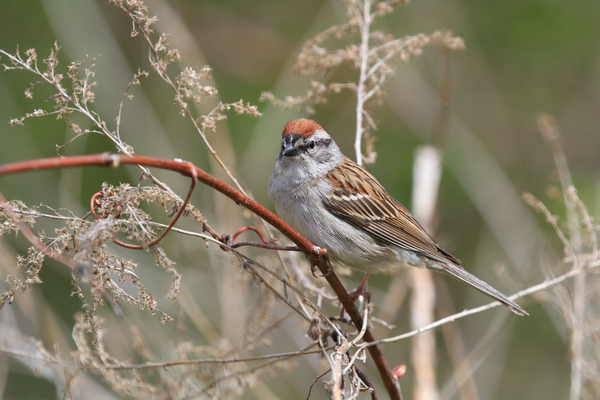 | Chipping Sparrow |
 | Clay-colored Sparrow |
 | Common Grackle |
 | Brown-headed Cowbird |
 | American Goldfinch |
 | Downy Woodpecker |
 | Western Meadowlark |
 | Mourning Dove |
 | Blue Jay |
 | Dark-eyed Junco |
 | European Starling |
 | Yellow Warbler |
 | Red-winged Blackbird |
Common Birds of North Dakota
1. Song Sparrow

The backs of Song Sparrows are grey with brown striping. Their brown wings are short yet wide, with grey tips, and their long brown tails are active and perky. The underbelly and breast of this bird would be grey or white having brown streaks, while the face of this bird will majorly be of grey color.
The silver beak of this bird is short, robust, and conical.
Length
These birds have a wingspan of 7.1 to 9.4 inches and a length of 4.7–6.7 inches from head to tail.
Habitat & Food
These birds may be seen in a variety of settings, including desert washes, overgrown fields, and marshes. They frequent backyard feeders.
These birds enjoy peanuts, nuts, and suet cakes.
2. American Robin

These species can be found in different locations in North Dakota at different seasons of the year, including springtime, summertime, fall, and winters.
The robins go south from their nesting sites in Mexico for the winter, but they return in the springtime to take up residence in North America.
This is a species of great importance. From beak tip to tail tip, this bird is 10 inches long. A fat creature with a lengthy tail. Their bills are straight and narrow, with a curved tip. The upper parts are gray-brown, with a reddish-orange breast.
Food
On the lawn, there are worms and other creatures. Berries from a bird feeder or the grass are acceptable to these birds. Small berries from shrubs and trees can be eaten.
3. Chipping Sparrow

With a buffy grey chest, rusty red cap, tan streaked and brown wings, and a black line through to the eye with white atop, these birds have their most immaculate feathers in the summer. Their markings may seem less distinct and buffy-brown in the winter.
They’re common sparrows who prefer to graze on grass.
Length
These little birds have a head-to-tail length of 4.7–5.9 inches and wingspans of 8.3 inches.
Habitat & Food
These birds can be seen along the forest’s edge, in pastures, stands, or hillsides, since they like open places. They frequent gardens, parks, and backyards for their diet, suet, cracked corn, rolled oats, and these birds like any type of sunflower seed.
Bugs and seeds are the most common. Seasonal diets differ. In the summer, it eats dragonflies, butterflies, insects, leafhoppers, other insects, and spiders. It eats a variety of seeds throughout the fall and winter.
4. Clay-colored Sparrow

The backs of Clay-colored Sparrows are tan with dark brown striping. Their wings and tails are the same color as their backs, and they have pale breasts and underbelly.
A grayish-white chin and a white mustache line that reaches downward and then upward to the rear of the head distinguishes this bird. A white brow line also runs across the eyes and curls down where the color meets it.
Length
The bills of these birds are short, thick, and pale in color. These little birds are around 4.5 inches long measuring from the head to the tail, whereas they have a wingspan of about 7.5 inches.
Habitat & Food
This species prefers deep covered areas, like forest borders having bushes, where they may feed safely.
These tiny men and ladies like conifers, but you may also find them in overgrown fields and grasslands as they move about. Clay-colored Sparrows eat tiny seeds and berries when they aren’t eating insects.
5. Common Grackle

The order Passeriformes and the family Icteridae include common grackles. These creatures are can be seen in Cuba and United States
Grackles consume insects, insects, and termites that they find when rummaging through leaves or soil and nuts and cherries that have fallen on the floor.
Range
They are currently residing in the southeast of the United States. In the summer, they move towards the west as well as north to the central US and Canada.
Food
Grain, maize, acorns, tiny aquatic fish, and amphibians are some available foods. Use tube feeders instead of hopper or tray feeders to dissuade them. Don’t overfeed, and pick up spilled seed.
6. Brown-headed Cowbird

Their backs are gleaming black, and their wings are medium to long with tails of small size but similar hue. Their abdomen and breast are also black, but this bird’s head is light brown with a somewhat deeper coloring at the front.
These species possess thick, conical black bills that are medium in length. Females have a duller color, with a light brown overall hue and little streaking lines on the underside and breast.
Length
Males and females are slightly variable in structure, with males measuring 7.5–8.7 inches and females ranging from 6.3–7.9 inches.
The male wingspan is usually 14.2 inches long, whereas the wingspan for females lies between 12 and 15 inches long.
Habitat & Food
These birds like open environments like pastures, grasslands, and farms, where they may feed on the ground while resting and singing in the protection of high, adjacent branches. Cowbirds love crushed grain, White Proso millet, and any type of sunflower seed.
7. American Goldfinch
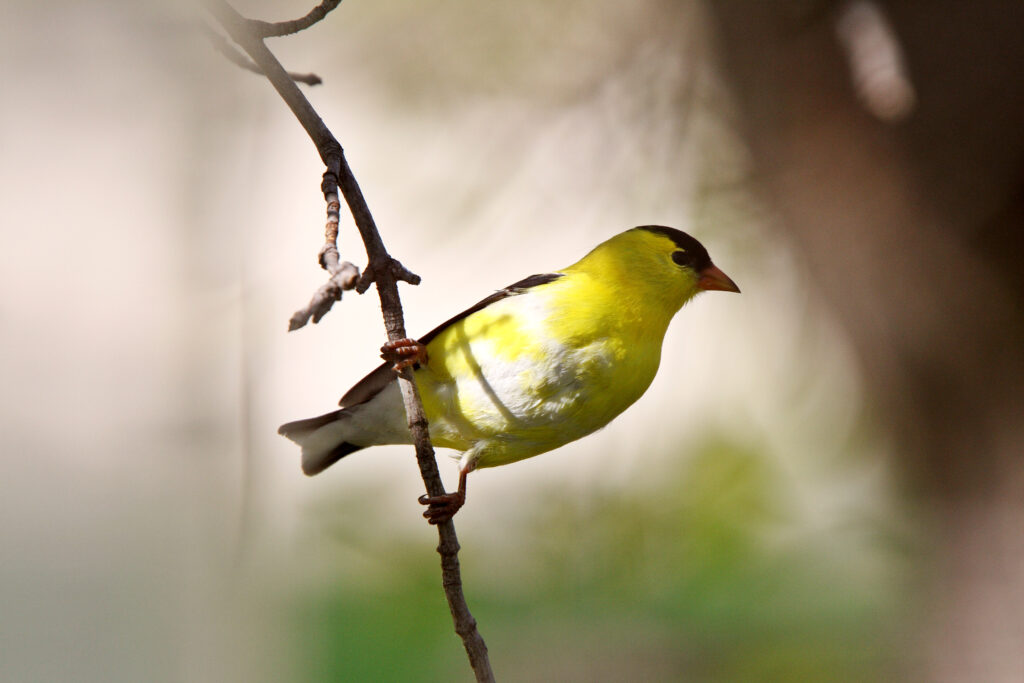
The American Goldfinch appears to be a yellowish bird that may be seen all throughout North America. They can also be located in lawns and feeders.
Meadows, open forest, bushland, brushy regions with shrubs or hedges for nesting sites, and farm areas that have been harvested but not yet plowed under are among the habitats they like. In the summer, they eat insects, spiders, and fruit; in the winter, they eat mostly seeds.
From beak tip to tail tip, it’s just around 5 inches in length. Little in size and chubby, with a big head and a short tail. Pink, conical, and short. Males are brilliant lemon yellow in the summer, with black wings and tails, black forehead, and white bars. The undersides of the tail coverts are white. Females have a drab olive color, with browner wings and tails.
Food
It eats weed seeds and thistle seeds. Sunflower seeds from the tube feeder may be eaten.
8. Downy Woodpecker

Downy Woodpeckers have long, black wings and small, stiff, notched black tails, as well as a the striation of white color upon their backs
Beginning just under the shoulder and continuing to the end of the wings, the wings will have a spread pattern of stripes.
Length & Habitat
With wingspans ranging from 9.8 to 11 inches and lengths of about 6 inches measuring from head to tail, these birds are rather large. Downies like deciduous forests, especially if there is brush or thicket protection nearby.
They also have a sweet taste. These adorable tiny birds enjoy eating suet cakes if placed in an easily accessible wire mesh.
9. Western Meadowlark

This species is distinguished by its distinct song and call notes; even when their territories overlap in the Midwest and Southwest, the two species of meadowlarks appear to be able to distinguish their kind in the same way; they practically never interbreed.
Its bill is frequently used to probe the soil. The major part of its diet comprises insects, particularly in the summer when it consumes a large number of insects, crickets, bugs, worms, ants, and other insects, as well as spiders, snails, and sowbugs.
Nuts and waste grain account for nearly a third of the yearly diet, and they’re especially popular in the fall and winter.
Habitat
These birds are migratory birds that visit North America. This bird may be found in various settings, including meadows, grasslands, pastures, and farms.
Food
This species mostly eats insects, although it will also eat nuts, fruits, and small animals if they are available. These birds are long-distance migrants who fly roughly 805 km per day during their autumn journey northward; some have been known to travel over 2415 km in one day.
10. Mourning Dove

Mourning doves are the most widespread backyard bird. From beak tip to tail tip, it’s around 12 inches long. . Smaller than the domestic city pigeon. Small round head with a fat body. Legs are slender.
Bill is a small, skinny man. The body is a light brown-pink color, with darker wings and tail. On the side of the tail, there are white borders.
Habitat
Urban regions, farmlands, and woodlands are examples of semi-open spaces. Mourning Doves nearly solely consume seeds on a large feeder or on the ground with sunflower seeds.
Doves, which are about the size of a robin, are prevalent in backyards and can be found sitting on telephone lines or in groups in trees. They can be seen occasionally on a tray feeder, but they are more frequently spotted roaming about on the ground.
Mourning doves are primarily grey in hue, with black dots on the top, a delicate peachy tone beneath, and pink legs. During the spring and summer, mourning doves may be seen all around the state.
11. Blue Jay

The Blue Jays are a group of birds that live mostly in North America. They may be found across the U.s, with some even making it to Central America. They graze on nuts, fruits, grains, and insects in pine forests and mixed woods.
This species migrates in two ways: one from the north to the south during the winter months and another from the north to Central America and the Caribbean during the summer. They have a big blue crown on top of their heads, blue feathers largely down their backs, and white feathers on their breast and belly.
They also wear a black ring. They produce a variety of harsh, metallic sounds and are frequently the first to warn other birds in the vicinity of a predator like a hawk.
Habitat
The Blue Jay is a year-round inhabitant of North Dakota’s whole state. Forages on the ground and in trees and plants. Seeds or suet are attracted to feeders. Bill is pounding on hard nuts or seeds to break them open. Acorns will be harvested and stored in holes in the ground.
The Blue Jay is recognized as one of the loudest and most colorful birds in eastern backyards and woodlots. It can eat nearly anything and is fast to reap the benefits of bird feeders since it is intelligent and flexible.
When maintaining their own nest or seeking to loot another bird’s nest, they are not always visible, slipping stealthily through the woods.
12. Dark-eyed Junco
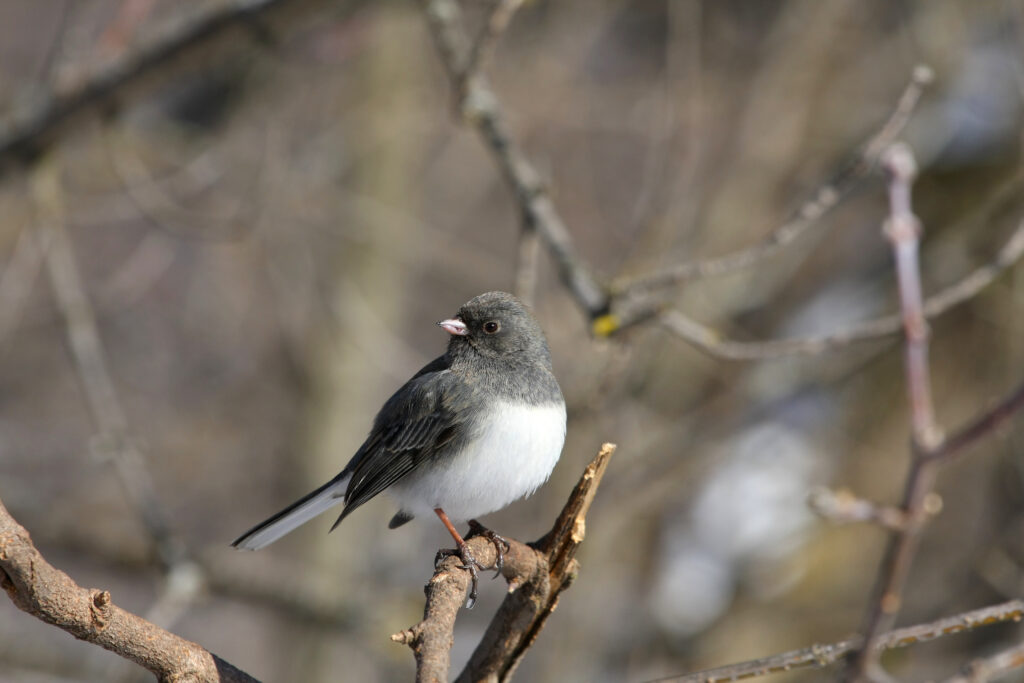
The Dark-eyed Junco is a tiny gray-brownish bird that may be found across North America. They’re rather abundant and may be found in both the United States and Canada. Juncos prefer to hang out near water sources like ponds or streams, where they graze on bugs, earthworms, and other insects that reside low to the ground.
When they can’t migrate south or find refuge during the winter, they eat grains and other plant components; otherwise, they eat insects, including termites, bugs, larvae, and spiders.
During the winter, groups of Juncos can be seen eating on the ground along forest boundaries and residential yards over most of the continent, producing ticking noises as they take flight into the bushes.
Juncos are totally grey and white, but in the West, they come in a variety of colors, including red and browns on the back, sides, or even both; some of these were once considered to be distinct species.
In the summer, the forms have different ranges, but in the winter, numerous varieties may be seen in the same flock in some regions of the West.
Forages largely on the ground while hopping and sprinting. It scrapes on leaf litter or snow with its foot on occasion. Bird feeders are visited, although it prefers to scavenge on the ground beneath the food tray.
13. European Starling

European starlings are non-native bird species that arrived in North America in the late 1800s. These birds may be found all across the U.s, although they are most common in Eastern North America. Woodlands, waterways, and farmlands are popular habitats for these birds.
Habitat & Food
They eat mostly strawberries but will also eat bugs, nuts, seeds, and smaller animals or lizards on occasion. When food supplies are sparse in the winter, European Starlings move south, then return north as soon as the weather warms up.
Mostly forages on the grass in open places, probing the earth with its bill. Forages in flocks most of the time.
Bugs, nuts, and grains are the most common. The diet is fairly diverse. When available, eats primarily insects, such as insects, locusts, moths, worms, snails, worms, termites, and other invertebrates.
The male builds a territory and selects a nesting location while singing to lure a partner. When a female comes, the male sits near the nest and sings while flapping his wings. A male may have more than one partner.
The nest is frequently found in a natural hole or woodpecker hole in a tree, a birdhouse, or (in the southwest) a hole in a huge cactus, of holes and fissures in structures, as well as other unusual places.
Nest construction is usually started by the male and finished by the Female (who may discard part of the male’s nest material). Willow, bushes, grass, leaves, rubbish, and feathers make up the nest, which has a little depression for the eggs.
14. Yellow Warbler

Yellow Warblers are tiny birds belonging to the warbler family of the New World. Canada, the United States, and Central America are all home to them. Typically, they live in woodlands or bushes near water sources.
During the winter, these birds travel south to warmer regions such as Southern America and Mexico in search of food supplies that aren’t accessible in North America at this time of year.
Forages from the ground up to the tops of the trees. Takes insects off twigs and foliage, pauses momentarily to get objects from the leaf surface, and then flies away after flying insects. Males browse at a greater elevation and in more open foliage than females. In the tropics, forages alone in the winter, protecting a winter feeding zone.
The majority of the creatures are insects. Caterpillars of various sorts may account for up to two-thirds of the diet. Flies, caterpillars, flies, bugs, dragonflies, other insects, and spiders are among the creatures it consumes.
Singing and fluttering flying displays are used by males to protect breeding areas. The Female is courted by a man who pursues her for 1-4 days.
Nest: 2-60′ above ground, on upright forks of branches in bushes, small trees, and briars.
Males will sometimes follow females to the nest and assist in construction. Females will take materials from other nests in order to build their own.
15. Red-winged Blackbird
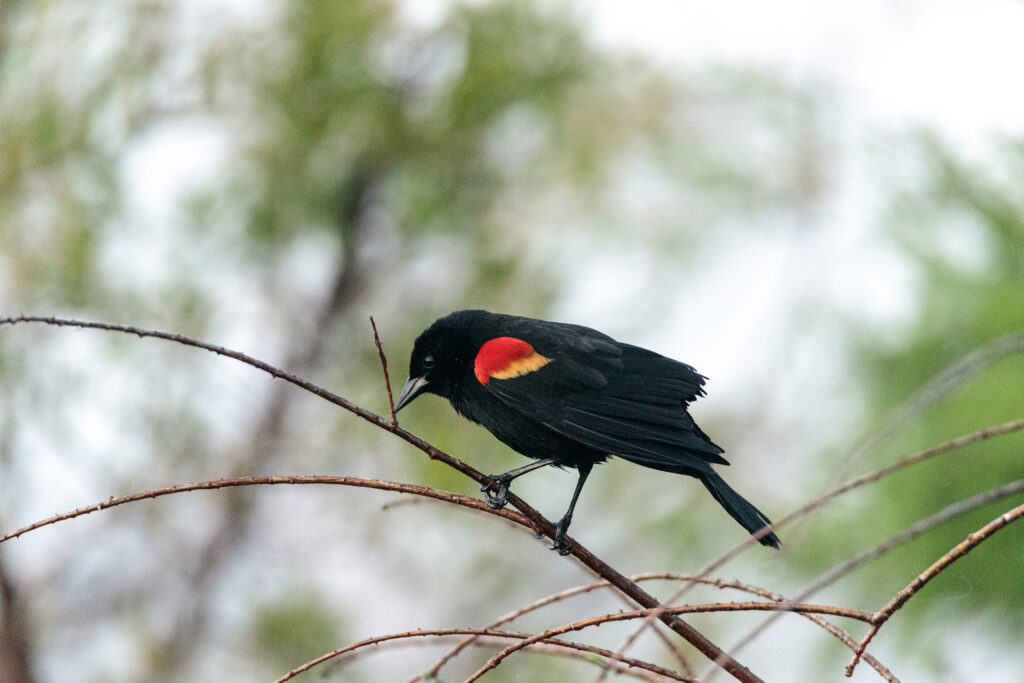
Red-winged Blackbirds are migratory birds found across North America, from northern Mexico to Canada. They breed on grasslands, marshes, and farm areas, among other open habitats.
They may be found in locations with thick vegetation and water sources such as marshes, ponds, and streams during the winter months.
Their food consists of bugs and other invertebrates during the breeding season, whereas seeds, nuts, berries, and grain crops are consumed during the winter months. Temperature changes are the primary driver of their migration pattern.
They are fearless, and several may fight a larger bird that flies over their nesting territories, such as a hawk or crow. The male’s crimson shoulder patches, usually buried behind his body feathers, are brightly shown when he sings.
Red-winged blackbirds roost in large flocks outside of the breeding season. Forages primarily when strolling on the ground but also in bushes and trees. It forages in flocks outside of the mating season and is frequently seen with other starlings and blackbirds.
Insects and seeds are the most common. Larvae, moths, crickets, other insects, crawlers, centipedes, and snails are among the creatures it eats, especially in the summer.
Seeds, including grasses, weeds, and waste grain, make up most of an adult’s yearly diet (about three-quarters). Eats berries and tiny fruits as well.
If you are wondering about South Dakota Birds, then check this article on Birds of South Dakota.
Conclusion
In this write-up, various common dweller birds have been discussed that you may notice in your backyards if you are settled in North Dakota.
We have talked about the vibrant body features that will help identify them, and their foraging regime has also been discussed in case you seek to lure these birds to your feeders.
FAQ
What are the most common birds in North Dakota?
American robins are prevalent birds in North Dakota.
Are European starling native species to North Dakota?
No, these birds migrate to North Dakota.
What is the state bird of North Dakota?
The state bird of North Dakota is the western meadowlark.
Which family does the yellow warbler belong to?
They belong to the warbler family.
Last Updated on March 22, 2023 by Lily Aldrin
